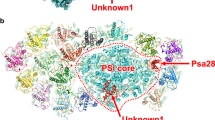Abstract
Arising from B. D. Zoltowski et al. Nature 480, 396–399 (2011)10.1038/nature10618
Recently, we determined the X-ray crystal structure of full-length cryptochrome from Drosophila1. Here we report an improved model of the Drosophila cryptochrome (dCRY) structure that corrects errors in the original coordinates (Protein Data Bank (PDB) accession 3TVS). Further refinement of the structure, with automated rebuilding algorithms in Phenix2 followed by manual building, indicated that a model of dCRY could be produced with excellent refinement statistics without taking into account the non-merohedral twinning originally reported (Table 1).
This is a preview of subscription content, access via your institution
Access options
Subscribe to this journal
Receive 51 print issues and online access
$199.00 per year
only $3.90 per issue
Buy this article
- Purchase on Springer Link
- Instant access to full article PDF
Prices may be subject to local taxes which are calculated during checkout




Similar content being viewed by others
Accession codes
References
Zoltowski, B. D. et al. Structure of full-length Drosophila cryptochrome. Nature 480, 396–399 (2011)
Afonine, P. V., Grosse-Kunstieve, R. W. & Adams, P. D. The Phenix refinement framework. CCP4 Newslett. Number 42, contribution 8. (2005)
Author information
Authors and Affiliations
Contributions
The New York authors (B.D.Z., A.T.V., D.T., J.W., M.W.Y. and B.R.C.) carried out the work presented in ref. 1; the Manchester authors (C.L., A.R.J., N.S.S. and D.L.) identified errors in the original coordinates; together, both sets of authors carried out the further refinement of the structure presented here. C.L. initially identified errors in the original coordinates, and C.L. and D.L. performed initial model rebuilding and crystallographic analysis, which was verified and discussed with A.R.J. and N.S.S. The New York authors B.D.Z. and B.R.C. completed and verified the model rebuilding and crystallographic analysis. The New York authors A.T.V., D.T., J.W. and M.W.Y. contributed to structural analysis and verified the new structure against existing biochemical and biological data. B.R.C. and B.D.Z. wrote the communication with input from all other authors.
Corresponding author
Ethics declarations
Competing interests
Competing Financial Interests Declared none.
Rights and permissions
About this article
Cite this article
Levy, C., Zoltowski, B., Jones, A. et al. Updated structure of Drosophila cryptochrome. Nature 495, E3–E4 (2013). https://doi.org/10.1038/nature11995
Received:
Accepted:
Published:
Issue Date:
DOI: https://doi.org/10.1038/nature11995
This article is cited by
-
Essential elements of radical pair magnetosensitivity in Drosophila
Nature (2023)
-
Direct experimental observation of blue-light-induced conformational change and intermolecular interactions of cryptochrome
Communications Biology (2022)
-
Tuning flavin environment to detect and control light-induced conformational switching in Drosophila cryptochrome
Communications Biology (2021)
-
The tail of cryptochromes: an intrinsically disordered cog within the mammalian circadian clock
Cell Communication and Signaling (2020)
-
Isoform-selective regulation of mammalian cryptochromes
Nature Chemical Biology (2020)
Comments
By submitting a comment you agree to abide by our Terms and Community Guidelines. If you find something abusive or that does not comply with our terms or guidelines please flag it as inappropriate.



